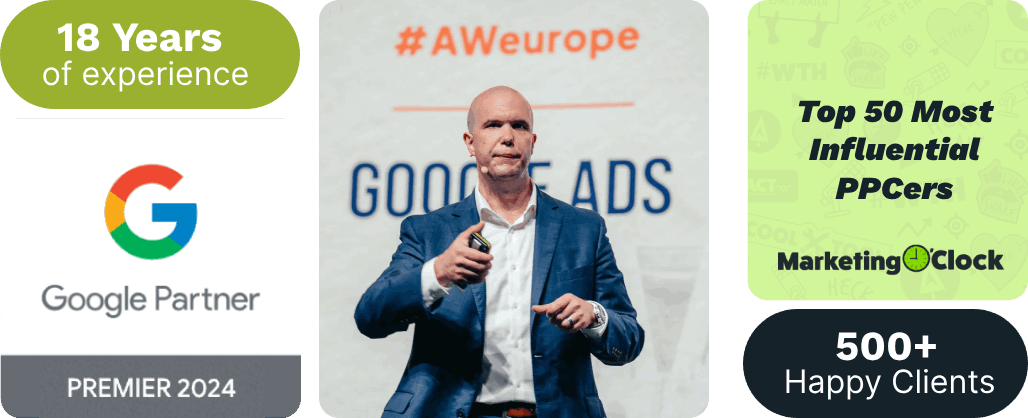Quality clicks are everything in PPC advertising — especially in Google Ads.
Your clickthrough rate (CTR) shows you how many searchers clicked on your ad, which gives you an idea of how well your ads are performing.
So, if you want to improve your expected clickthrough rate in Google Ads, here are five ways to make it happen, all while minimizing wasted clicks and improving campaign performance!
Content:
Be specific
Add negative keywords
Responsive search ads are the way to go
Use extensions to infinity!
Bid adequately

1. Be specific
This may not be new to you but we’ll start with the basics.
Ad group structure is a crucial factor in ad copy creation. And for CTR improvement, you need to have very specific ad groups.
Your search terms and what’s in your ad copy need to be thematically connected.
Why?
Because with the expected click-through rate, Google is guessing at how likely it is that somebody will click on your ad.
So, if you have broader ad groups, the lower your click-through rate will be in direct proportion to the expansiveness.
When you create an Ad Group, Google typically suggests some keywords based on your main keyword.
But don’t rely on Google for your keywords. You can use the suggestions as a basis but you have to decide how granular you go.
Also, many of the suggested keywords are too broad and will include common words that could get your ad to show up for irrelevant searches.
The more you show up for irrelevant searches, the lower your CTR and conversions will be.
Break up your ad groups to make sure that you can be as contextually appropriate as possible.
Just remember, if you can’t get specific enough, your ad groups are probably too broad.
2. Add negative keywords
You want your ad to show up when people search for the keywords you’re targeting, but you don’t want your ad shown for a bunch of other search terms that aren’t relevant to what you’re selling.
You can do this by adding negative keywords.
Negative keywords help you avoid wasting money on clicks from unqualified leads.
Adding negative keywords won’t let your ads show up to people who aren’t interested in what you’re offering.
By eliminating this wasted ad spend, you can focus your budget and efforts on the people who are actually looking for what you’re selling.
This can then improve the quality of your traffic, increase CTR in Google Ads, and increase your conversion rates
Here are two common examples of negative keywords:
- “Cheap” – If someone searches for “cheap” pants, they’re most likely looking for sale items or something inexpensive. You probably don’t want them clicking on an expensive pair of shoes that cost hundreds of dollars, so use negative keywords like “cheap” or “discount,” depending on how specific you want to be.
- “Free” – This one is really similar to “cheap.” If someone searches for “free,” they’re probably looking for something that won’t cost them anything, whether it’s free shipping or something else. Again, use negative keywords such as “free” or “free shipping.”

3. Responsive search ads are the way to go
Responsive search ads are all about your ad standing out in the SERPs and getting more clicks.
And according to Google, responsive ads have a 5-15% higher clickthrough rate.
Responsive search ads are perhaps most impressive for their versatility when it comes to ad copy.
It’s also a way of telling Google what type of user you want your ad to appear for. Google will use machine learning to determine which combination of headline and description works best for that audience.
This means you can set up your different content variants (up to fifteen headlines and four descriptions) once, then let Google figure out which one will convert best.
They’re also called “responsive” because they can adapt to show more text, depending on the user’s device.
Responsive ads are essentially the way of the future. If you don’t take advantage of this, you’re going to be left behind.
4. Use extensions to infinity!
Extensions are important and you always want to use them because Google tends to prioritize campaigns with Extensions.
Ad extensions can improve your click-through rate and your Quality Score. And, they’re also a factor in ad rank.
If you don’t have any ad extensions, you will have no extensions impact.
If you are only eligible for one extension, you will have a low extensions impact. But if you are eligible for many extensions (so, you include direct page links, a phone number, and address in your ad, for example), you will have a high extensions impact.
And, because it factors into your quality score, the more extensions you have, the better your ad will perform.
Check out our Sitelink Extension Tutorial.
5. Bid adequately
The last tip we have to improve clicks is short but might burn — bid competitively!
You may not know it, but half the time, you’re just not spending enough money especially if you’re in a very competitive market.
In a highly competitive environment, you have to spend money to win the clicks that matter.
Don’t be afraid to raise your CPC. You can always lower it again if you find that it’s no longer working for you. Otherwise, it’s going to hurt your CTR in the long run.
Your CPCs must be competitive with your highest competitors.
One thing to note: Don’t always go after the top spot. You need to find a balance between being at the top to gain leads that convert and spending within your marketing budget.
That’s it! Hopefully, you’ll see a boost in your CTR with the tips above. Improving your expected clickthrough rate (CTR) on Google Ads can be a bit tricky, but with a little bit of know-how and some hard work, it’s possible to have an effective campaign. And the payoff is worth all of the effort!
If you want to learn more about Google Ads and the process of running successful campaigns, we know everything there is to know about Google Ads. You can also subscribe to our YouTube channel for daily education and free knowledge bombs.
Author
Joan is the YouTube Growth Manager at Solutions 8. When she’s off the clock, you’ll find her chilling with her 10 fur babies, pushing her limits in CrossFit sessions, or basking in the serenity of the beach.
 Joan Porio
Joan Porio










